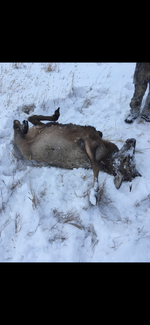I figured you might chime in. Comparing your skill set to the average elk hunters or the newbie elk hunter is like comparing my basketball skills to Michael Jordan’s.I’m guessing that you shoot more center fire rounds in a month than the average hunter does in a decade or even a life time.
I see lot of new hunters/shooters take quite a few animals each year. I was
not a small caliber/cartridge person at all. Very much was taught and believed that real cartridges for game started at 300WM. However, everything I have seen, and I mean everything- killing that few could fathom, has shown unequivocally that everyone shoots less recoil, less noise, and less blast better than more; and the .224 with good bullets has by far the highest success rate and lowest screwup rate of any combination regardless of angle or presentation.
A properly placed round will kill, there’s no argument to that. That being said I’ve seen enough shit go wrong that I wouldn’t recommend that the average guy shoot the smallest legal caliber for elk. I’ve been apart of some shitty recoveries due wrong bullets, marginal hits, etc. I’ve also seen a few marginal hits with big enough bullets that I fully feel that it made a significant enough difference to ensure recovery.
I log and have logged the results of animals being killed for quite a while. That is type of animal, presentation, range, location of shot, bullet and impact speed, animal reaction, and results including distance traveled, and tissue damage. A few major things stand out like blinding lights-
- distance traveled after the hit has about zero correlation with caliber. It has almost everything to do with what is hit.
- as recoil goes up, the amount of gut shots, wounds, and misses skyrocket. 30cal mags average 1 to 3 animals out of every 10 that have a major screwup. 223/77gr TMK is about 1 in 150 animals- from antelope to moose.
- very few bullet/cartridge combinations make any difference at all in poor shots. Those that do, almost no one wants to use due to meat loss. Even still, using them the percentage of bad shots skyrockets compared to others.
- Projectiles matter greatly, caliber almost not at all. There is a very real difference in time to incapacitation, distance traveled, overall success between deep penetrating, narrow wounding projectiles, and heavy for caliber rapidly fragmenting projectiles.
As far as bulls go, I’ve seen several eat lead, even with well placed shots and make it far enough that it sucked significantly more than it could have on recovery.
So have I, though cow elk more than bulls. The first bull I killed took 4 rounds of 300WM. The only reason it wasn’t more is because I severed the spine in the neck with the 4th round. I’ve seen elk take between 1-7 rounds with .224, .243, .257, .264, ,277, .284, .308, .338 caliber rounds. We do not shoot and then sit back and watch the animal for 30 seconds until it falls over. If it is still on its feet, it keeps getting shot- quickly.


